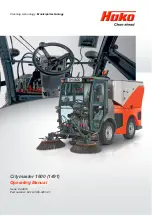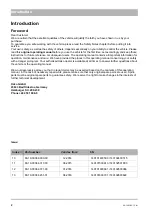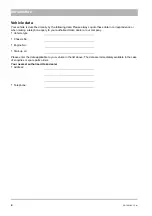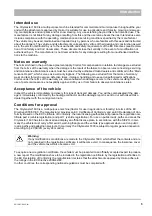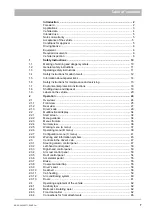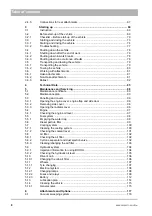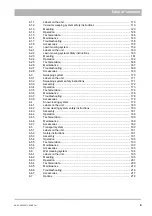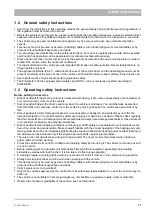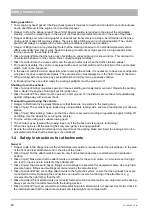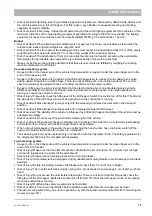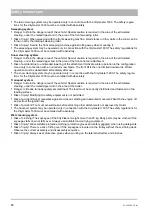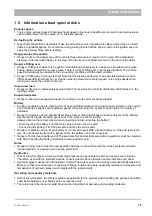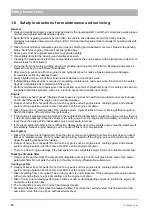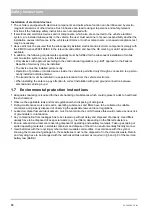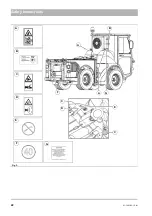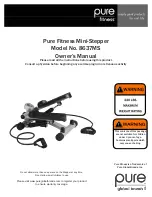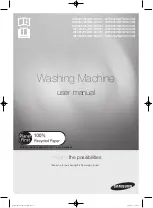
01-1491-00-12.fm
11
Safety Instructions
1.2
General safety instructions
•
Apart from the instructions in this operating manual, the general safety and accident prevention regulations of
the legislation must be taken into account.
•
Before the vehicle is put into service, please read carefully the operating manual you receive as well as further
separate instructions for additional implements or attachments and observe them in all aspects in your work.
•
The vehicle may be used, maintained and repaired only by persons who have been instructed by Hako
experts.
•
This device may not be used by persons (including children) with reduced physical or mental abilities or by
persons without sufficient experience and skills.
•
You should pay special attention to the safety instructions. For errors in operating the vehicle can be avoided
and trouble-free operation can be guaranteed only with precise factual knowledge.
•
Please hand over these documents as well as the approval documents to the new owner/operator on sale or
rental of the vehicle. Have the hand-over confirmed!
•
The labels attached to the vehicle provide important information for safe operation. Renew labels that are no
longer legible or present.
•
The approval certificate (Part 1), valid driver's license of the vehicle driver and the operating manual must be
present constantly at the place of use of the vehicle and should therefore be kept carefully in the driver's cab.
•
Spare parts must be original spare parts to guarantee safety.
•
The Citymaster 1600 is equipped with a safety cab (ROPS – roll-over protection system) according to
86/298/EEC.
1.3
Operating safety instructions
Before putting into service
•
Risk of accident! If the steering column is unlocked while driving, it can come unexpectedly out of adjustment.
You can then lose control over the vehicle.
•
Risk of accident! Adjust the driver's seat only when the vehicle is stationary. You will otherwise be diverted
from the traffic and could lose control over the vehicle by moving the seat. You could cause an accident by
this.
•
Risk of accident! A dirty, damaged seat belt or one stressed or changed in an accident may not offer the
intended protection. You could therefore suffer severe injuries or death in an accident. Please check regularly
that the seat belts are not damaged and not contaminated. Always have damaged seat belts or those stressed
in an accident renewed by an authorised workshop.
•
Risk of accident! Good viewing conditions contributing to traffic safety are guaranteed only if all windows are
free of ice, snow and condensation. Make yourself familiar with the correct operation of the heating and venti-
lation system as well as de-moisturising/defrosting the windows. Maximum heating power and fast thawing of
the windows can be achieved only if the engine has reached its operating temperature.
•
There is a risk of accidents when driving with open doors! The doors must remain closed when driving on
public roads and when working.
•
Check the vehicle for its correct condition and operating safety before using it. The vehicle must not be used if
it is not in order.
•
Before starting work, the operator must familiarize himself with all equipment, operating and actuating
elements as well as with their function. It is too late to do this during operation!
•
A warning triangle, a warning light, a warning vest and a first aid kit must be in the vehicle during operation.
•
Sturdy and slip-proof shoes must be worn when working with the vehicle.
•
This device may not be used by persons (including children) with reduced physical or mental abilities or by
persons without sufficient experience and skills.
•
Carrying persons is not permitted!
•
Only those surfaces approved by the contractor or its authorised representative for use of the vehicle may be
driven on.
•
The vehicle is not suitable for removing dangerous, combustible or explosive liquids, dusts or materials.
•
Observe the maximum gradability of the vehicle, see Technical data.
Summary of Contents for Citymaster 1600
Page 22: ...22 01 1491 00 12 fm Safety Instructions G A B D E F Fig 3 C F C E C D G A B A...
Page 26: ...26 02 1491 00 11 fm Operation Fig 5 25 23 16 18 17 19 22 21 20 24 26 27...
Page 30: ...30 02 1491 00 11 fm Operation Fig 7 62 63 61 67 55 50 51 54 53 52 58 57 59 60 65 64 66 68 56...
Page 32: ...32 02 1491 00 11 fm Operation Fig 8 75 69 78 73 72 79 80 81 82 83 74 77 70 71 76 84...
Page 85: ...04 1491 00 11 fm 85 Technical Data 4 Technical Data Fig 80 3830 1600 941 1210 975 1964...
Page 146: ...146 06 1491 00 12 fm Attachments and Options 6 1 5 Technical data Fig 144 2215 4510 1580 2250...
Page 220: ...220 06 1491 00 12 fm Attachments and Options...

